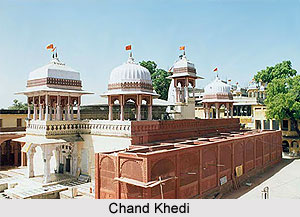 Chand Khedi is a small village located near Kota in Rajasthan. It serves as a Jain pilgrimage centre. An ancient temple of Bhagwan Rishabh Dev is situated here. Chand Khedi is located at a distance of 55 kilometres (34 mi) from Ataru railway station on Kota-Guna line of the Western Railway. There are several legends related to this temple. One of the famous rulers of the Mughal Dynasty, Aurangzeb had invaded the temple innumerable times but could not destroy the temple.
Chand Khedi is a small village located near Kota in Rajasthan. It serves as a Jain pilgrimage centre. An ancient temple of Bhagwan Rishabh Dev is situated here. Chand Khedi is located at a distance of 55 kilometres (34 mi) from Ataru railway station on Kota-Guna line of the Western Railway. There are several legends related to this temple. One of the famous rulers of the Mughal Dynasty, Aurangzeb had invaded the temple innumerable times but could not destroy the temple.
Legends of Chand Khedi
One of the legends associated with Chand Khedi relates to the time of Mughal period. During one of the invasions an axe damaged the toe of the idol of Rishabhdev. It resulted in the flow of milk which swept away the invaders. The temple was thus saved from the hands of the invaders. Another astonishing legend took place that in 2002. A Jain saint Sudhasagar, disciple of Acharya Vidyasagar belonged to the Digambara Sect of Jainism. It is said that he had dreamt about a location where crystal images of Jain Tirthankaras had been stored. As advised he found out the location near a cave and dug the earth. There he discovered three carved images of Jain Tirthankaras. They were made of `sphatik mani` i.e. clear transparent stone. He displayed the images before a huge gathering of Jain followers. One of the images was of Lord Chandraprabha. It was almost 2.5 feet in height. The second image belonged to Lord Arihant and the third one of Lord Parshvanatha. The images were even older than the 1200 year age of the village itself. These images safely stored for thousands of years under the earth. The images were of a rare nature, stunning in appearance and very appealing. These images are presently kept in safe custody of the temple authorities.




















